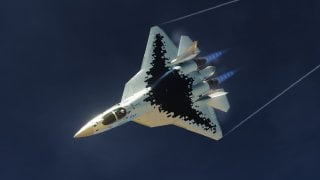Russia's Su-57 Felon Is Now the 'Wow' Fighter
The Zhuhai Air Show in Guangdong, China, showcased Russia's Su-57 "Felon," a fifth-generation fighter sparking mixed reactions. Initially mocked on Chinese social media for its design and perceived inferiority to China's Chengdu J-20, the Su-57 silenced critics with an impressive aerial performance.
This year’s Zhuhai Air Show in Guangdong, China, was a revelation for the world’s defense analysts. Heck, it was a learning experience even for the Chinese, who hosted what will be remembered as the ultimate military coming-out party. In fact, even among China and Russia—the friends who supposedly have “no limits” in their dealings—there was much sniping.
You see, the Zhuhai Air Show is not just for China to display its advances in aerospace technology. It’s a global event: Russia was there, too.
On the eve of the event, the Russians sent one of their iconic Su-57 ”Felon” fifth-generation warplanes. The plane has become a bit of an urban legend; despite the fact that it was built to be a major export model for Russia’s arms industry, and that it is one of the most advanced warplanes in Russia’s arsenal, it has been sparingly deployed to fight in the unfriendly skies above Ukraine.
This fact has helped to reduce its attractiveness among potential foreign buyers, who worry that Russia might not be deploying the Su-57 to fight in Ukraine because the plane isn’t as good as Russia claims.
Controversy at Zhuhai
The Chinese who attended the airshow in Guangdong got pictures of the Su-57 that was sent to participate in the Zhuhai Air Show. The photos they took went viral on Chinese social media channels—and not in a good way. Basically, Chinese social media users were mocking Russia’s purported fifth-generation warplane as being a sham. Chinese users attacked the appearance of the plane and generally denigrated it, while claiming that China’s own fifth-generation warplanes, especially the Chengdu J-20 “Mighty Dragon,” are better than the Russian Su-57s.
All the mockery and rumors about the inauspicious end to Russia’s fifth-generation warplane program, the Su-57, turned out to have been wasted. The Russians came to Zhuhai to impress, and the Su-57 did just that once it took to the skies. Instantly, the world saw the true scope and power of Russia’s most modern weapons.
The Russians even inked their first major export deal based on the stunning performance of the Russian Su-57 at the Zhuhai Air Show in Guangdong, China.
One of the primary reasons behind Russian hesitance to deploy the Su-57 into the dangerous combat conditions surrounding the Ukraine war is that the Su-57 is built with many high-end technological components from the West. Once the sanctions went into place, Russia had difficulty sourcing materials for the Su-57. Plus, Russian president Vladimir Putin and local governments had to dedicate all of their resources to a multiplicity of endeavors to directly support the Ukraine war. So, the fleet of Su-57s that Russia had at the start of the Ukraine war is basically the same fleet it has now.
Russian Fears
Moscow fears losing such an impressive, capable, and expensive plane. This is why Russia has used the planes sparingly. If any number of these planes are shot down, at least for a while, the Russians would have a dearth of Su-57 Felons on hand. But if Russia were to partner with China to build these systems, it might help both countries with their production woes.
For the Russians, it would allow them to build sufficient numbers of the Su-57 so that Moscow could then feel more comfortable deploying these warplanes into the intense battles (because they could easily be replaced).
In China’s case, it gives Beijing a huge advantage. China would gain more capable fifth-generation warplanes that are possibly better than what it currently has access to. If China were to build the Su-57 for Russia, they’d also get rich—and have access to these dynamic birds as well.
Alas, given Chinese social media’s response to the Su-57 at the Zhuhai Air Show, it is unlikely that Russia and China will be joining forces to build war machines of the future.
About the Author
Brandon J. Weichert, a National Interest national security analyst, is a former Congressional staffer and geopolitical analyst who is a contributor at The Washington Times, the Asia Times, and The-Pipeline. He is the author of Winning Space: How America Remains a Superpower, Biohacked: China’s Race to Control Life, and The Shadow War: Iran’s Quest for Supremacy. His next book, A Disaster of Our Own Making: How the West Lost Ukraine, is available for purchase wherever books are sold. Weichert can be followed via Twitter @WeTheBrandon.
Image Credit: Creative Commons.

